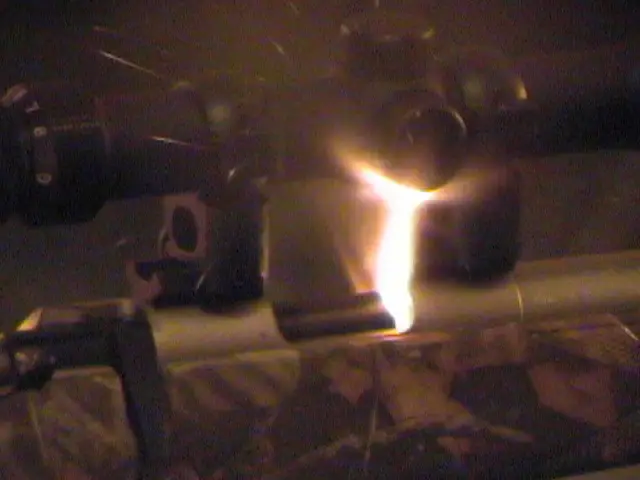


Technical Notes on Muzzleloading Propellants, Part Two
IGNITION TYPES
First, a brief look at a related subject: ignition types. In terms of gas volume output, ballpark figures are as follows, expressed in cubic centimeters. A 209 shotshell primer is, by far, the highest strength readily available primer. This should surprise no one, for a 12 gauge shotgun is .73 caliber.
209
shotshell 20
No. 11 cap 6
musket cap 14
small pistol 7
large pistol 11
small rifle 7.5
large rifle 12
Pressure obviously depends on volume, both of space and the amount of gas fitting the space. This is why breechplug design plays such an important role. For example, consider the Knight full red plastic jacket type of 209 ignition. Despite the high volume of gas produced by a full-strength 209 shotshell primer, only a portion of it is allowed to flow through the breechplug . . . which has a nipple. Shooting over the snow, you'll see gas hitting my face. You might find it soothing on a cold day. A close up shows the inefficiency of the nipple array when fired.


Photo by Randy Wakeman.
It was an improvement over many 209 breechplugs; take a look at this miserable Traditions E209, below.

Photo by Randy Wakeman.
Inefficient, poorly sealed breechplugs cannot reliably ignite Blackhorn 209. The primer to breechplug interface is critical, both for ignition, and to avoid scope-burning and face-burning. Also, excessively long breechplugs (the peculiar, totally unnecessary "quick release" types), result in cooler gas and particulate matter getting to propellant, again sometimes creating ignition problems. It isn't a matter of primer or cap gas output alone, it is how efficiently that hot gas and particulate matter is used.
THE MARKET
The Black Powder/ Black Powder Substitute Market is comprised of hunters, reenactment shooters, cowboy action shooters and 45/70, 45/90 and 45/100 shooters. The "Black Powder Substitute Domestic Market" is estimated to be about 1.5 million pounds annually with the majority of this in pellet form used for hunting. It is estimated that there is an additional .5 million pound market internationally mainly in granular form. Approximately 7.5 million muzzleloading hunting licenses were issued in 2007.
Needs and preferences vary. Reenactment shooters prefer granular form, authentic characteristics (smoke), moisture resistance, and widespread chain store distribution. As they do not fire projectiles- velocity is totally unimportant.
Hunters & shooters often prefer a low or non-corrosive propellant, with good moisture resistance, often like pellet form, want low residue for ease of multiple loadings, higher velocities, good availability, and want less smoke than black powder. Better visibility means better, quicker game recovery.
THE CHOICES
Ironically, the very best choice for hunting and shooting is exactly the same best choice for all firearms for the last 125 years has been: "modern smokeless powder." It is non-corrosive, high velocity, low residue, low recoil, and you can see your shot hit the animal. It fulfills all the wants and needs of hunters except you have to carefully weigh or measure your powder. Additionally, there is the "big dummy" factor. Shooting out ramrods, double or quadruple loading, all of these things are done again and again by sloppy hunters and shooters. Muzzleloaders are just idiot-resistant, not idiot-proof. It is this persistence of idiocy that ended the over 12-year production run of the Savage 10ML-II. Like it or not, if you build lawnmowers, stepladders, or firearms in the United States, you are going to get sued. Even if you did nothing wrong, you'll get sued. Major manufacturers of firearms have to consider how much justice they can afford.
PYRODEX

Containing significant amounts of sulfur, Pyrodex loose powder has good availability and easy ignition. Low velocities and high corrosivity make it undesirable by comparison with later blackpowder replacements.
TRIPLE SE7EN

Triple Se7en has excellent availability, is gluconic-based with no sulfur. The higher velocities are there, and those who can't be bothered to measure powder have pellets. It is corrosive, though, not nearly as bad as Pyrodex, but leaves a crud ring, and requires swabbing between shots. Triple Se7en sucks moisture, worse than Pyrodex, and has a very poor shelf life as a result. If you can't weigh or measure powder, pellets have the obvious appeal. The tradeoff is the high cost per shot, and licking patches then swabbing your barrel after every shot.
BLACKHORN 209
Blackhorn 209 is a two-part dedicated blackpowder replacement specifically designed for inline muzzleloaders. It is essentially non-corrosive, but does contain a minute amount of sulfur. It has superior shelf-life and is not prone to absorbing moisture. No swabbing is required (or recommended), it is just load and shoot, load and shoot. It needs an efficient breechplug, and is not suitable for sidelocks. It is a granular propellant, so those with an affinity for globs, pellets, pills, or tablets are out of luck. Assuming you have a good quality inline muzzleloader, it is currently the best choice available today.
CONCLUSION
Where easy ignition and authenticity is important, as in reenactment shooters, a good grade of organic blackpowder is unequalled. Due to its classification as an explosive, for caplocks, Pyrodex (classified as smokeless) is often the available alternative.
Other than that, Triple Se7en pellets are the choice if you don't know how to measure powder, or just plain don't want to.
Blackhorn 209 is easily the propellant of choice, so long as you have a breechplug that is efficient. It works superbly well in the Savage 10ML-II (now discontinued), the LHR Redemption, Thompson Encores if you keep your breechplug drilled free of debris, and the Remington 700 Ultimate to name but a few example rifles.
Copyright 2014 by Randy Wakeman. All Rights Reserved.

Custom Search


